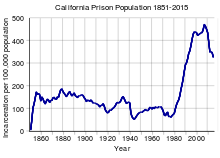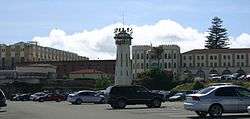Prisons in California
The California State Prison System is administered by the California Department of Corrections and Rehabilitation Division of Adult Institutions, which had 136,000 inmates as of 2014.[1] The state of California also relies on private and leased prisons. The number of California prisoners in private out of state facilities is around 8,763 and 4,170 are housed in leased facilities within the state.[2] The Corrections Corporation of America leases the California City Correctional Center.[3] The GEO Group is another private owner of facilities in California, such as the Golden State Modified Community Correctional Facility.[4]
Background
The California system has been the origin of many trends in prison conditions within the United States as a whole. The state's large and diverse population, large size, large urban areas, high rates of violent crime, criminal street gangs, tough sentencing laws and its status as an entry point to the U.S. for both immigrants and drugs has given California a large and complex prison environment. California prisons are overcrowded, with a number of facilities holding more than 200% of their design capacity.
The system lacks a racial/ethnic majority among the population. In 2011, according to a California Department of Corrections and Rehabilitation report, Hispanic inmates made up 39.8% of the population, African American inmates 28.9%, and white inmates 25.2%, with 6.1% classified as "other."[5] Prisoner identification and affiliation is tied closely to race and region of the state, which has contributed to tension and violence. There has been a long running racial tension between African American and Southern Mexican American prison gangs and significant riots in California prisons where Mexican inmates and African Americans have targeted each other particularly, based on racial reasons.[6] California is the birthplace of the United States' most powerful and well-known prison gangs, including the Aryan Brotherhood, Mexican Mafia, Nuestra Familia, and the Black Guerrilla Family. State efforts against these gangs made California a pioneer in the development of Security Housing Unit "supermax" control-unit facilities.
Due to the overcrowding in the California prisons, The state of California was sued and now has to comply with federal court-imposed population cap.[7] The overcrowded conditions and accusations of inadequate medical facilities and mistreatment have caused the federal courts to intervene in the system's operation since the 1990s, appointing special oversight and enforcing consent decrees over the system's medical system and the SHU units and capping populations at several facilities. As of 2007, by order of federal courts, the system's medical system is under federal receivership, and a federal court may impose a mandatory limit on the system's total population by June 2007.
Prison growth and overcrowding

From 1982 to 2000, California's prison population increased 500%. To accommodate this population growth, the state of California built 23 new prisons at a cost of $280 million to $350 million apiece. California's prisons are public and are financed by the Public Works Department and operated by the California Department of Corrections and Rehabilitation. In 2015, California had a prison population of 129,593, which was lower than the peak prison population of 173,942 in 2006.[8] Beginning in 2006, when the prison population in California was at its peak, the state used out-of-state facilities to house inmates.[9] California's prison population in 2015 made up roughly 9.74% of the United States' total prison population, making up the second largest contribution to the country's prison population (second to Texas which contributed 12.32%).[8] The state funds the prison system's annual costs. In 2005 the state rate of incarceration was 616 per 100,000 adults, or about .6%.

Of the 160,000 prisoners in California, two-thirds are African-American and Latino. Approximately 17% were born abroad. Most prisoners come from California's high density population areas, however incarceration rates in less populated areas are higher than from more congested areas. About 62% of inmates in 2005 were sentenced from Southern California. The largest racial group in California prisons was whites from 1980 to 1986, blacks from 1986 to 1992, and Hispanics from 1992 to the present.[10]
Conditions
In 2011, 6,000 California prisoners partook in a hunger strike to protest the conditions to which they were subject.[11] Prisoners refused to eat until their five demands were met.[11] They asked for: 1) Removal of collective penalties and an end to departmental misconduct, 2) Revoke the debriefing policy, consisting of gang-affiliated inmates divulging information on their gang before being released, 3) Terminate long-term solitary confinement, 4) Serve nourishing and balanced meals, and 5) Implement a variety of rehabilitation programs and privileges for Security Housing Unit (SHU) inmates.[11] The protest gained traction in California prisons; at its peak, over 12,000 prisoners were taking part in the hunger strike.[11] The strike ended after 20 days when the California Department of Corrections & Rehabilitation announced that they would reassess every inmate in the Security Housing Unit.[11] The California Department of Corrections & Rehabilitation met few, if any, of the prisoners demands.[11] By 2013, only 382 of the 4,527 SHU inmates residing in California cases had been reexamined, and of those 382 inmates about half were released.[11]
On May 23, 2011 the Supreme Court ruled in a 5-4 decision in Brown v. Plata that overcrowded conditions in California prisons constituted a violation of the Eighth Amendment, which bans cruel and unusual punishments. The decision upheld a lower court decision which found that "an inmate in one of California's prisons needlessly dies every six or seven days due to constitutional deficiencies." The Court found that, at the time of the lower court trial, California jailed nearly twice as many prisoners as its prisons were designed to hold. In the majority opinion for the Supreme Court, Justice Anthony Kennedy wrote:
After years of litigation, it became apparent that a remedy for the constitutional violations would not be effective absent a reduction in the prison system population or expanded facilities.
Prison spending
7% of California's budget was spent on corrections during Fiscal Year 2013-2014.[12] As of 2016, California spends approximately $64,000 per prisoner per year.[13]
See also
References
- ↑ CDCR Population Report, October 1, 2014
- ↑ "California adds another private prison". Los Angeles Times. 2014-04-02. ISSN 0458-3035. Retrieved 2017-11-30.
- ↑ CDCR. "CDCR - California City Correctional Facility (CAC)". www.cdcr.ca.gov. Retrieved 2017-11-30.
- ↑ "FacilityDetail". www.geogroup.com. Retrieved 2017-11-30.
- ↑ http://www.cdcr.ca.gov/Reports_Research/Offender_Information_Services_Branch/Offender_Information_Reports.html
- ↑ Racial segregation continues in California prisons Archived February 23, 2006[Timestamp length], at the Wayback Machine.
- ↑ Lindsay, Shanara (June 4, 2017). [latimes.com "At 75,560, housing a prisoner in California now cost more than a year at harvard"] Check
|url=value (help). latimes.com. - 1 2 "United States Statistics". RAND State Statistics. Retrieved 2017-11-30.
- ↑ "Corrections Infrastructure Spending in California - Public Policy Institute of California". Public Policy Institute of California. Retrieved 2017-11-30.
- ↑ Archived October 30, 2008, at the Wayback Machine.
- 1 2 3 4 5 6 7 Pham, Juli. "California inmates hunger strike to improve prison conditions, 2013". Global Nonviolent Action Database.
- ↑ California Budget 2014-2015
- ↑ "Editorial - California's prison spending is out of whack". Los Angeles Times. 14 January 2016. Retrieved 20 July 2017.
External links
| Wikimedia Commons has media related to Prisons in California. |
